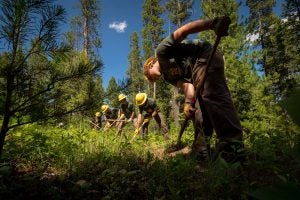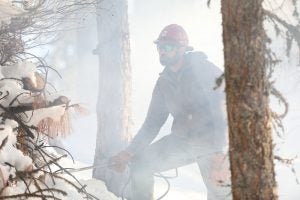The farm bill consists of multiple “titles,” or categories. These titles separate each topic and house different provisions that pertain to the omnibus legislation, which covers areas such as commodities, nutrition, and crop insurance. In the 2018 farm bill, there were 12 titles, and that is likely to remain the same in the 2023 reauthorization.
These titles don’t all get equal treatment in terms of funding — not by a long shot. The largest chunk of the designated federal dollars has historically gone to the nutrition, crop insurance, commodities, and conservation titles. The remaining titles compete for whatever money is left, which can cause some contention when farm bill discussions begin, as they already have. This is largely due to the fact that natural disasters, volatile markets, and economic instability continue to burden the agriculture industry, and therefore, every other title desperately needs more funding than what it may ultimately receive in the final piece of legislation.
One of those titles is Forestry.
While most of the forestry programs typically have permanent authorization, it can still be a focus of conversation each time a farm bill is up for expiration. On Thursday, March 8, the House Committee on Agriculture Subcommittee on Forestry, a newly formed committee, held a hearing titled, A Review of Title VIII: Forestry Stakeholder Perspectives.

The formation of the committee highlights a growing need to focus more on forestry management — as wildfires in the West have grown increasingly worse over the past years — and the importance of this title in the farm bill.
“Forestry will be a priority during the 118th Congress and Rep. [Doug] LaMalfa is a proven leader who is well-equipped to lead our new, standalone Forestry Subcommittee. Representing California’s First District, Rep. LaMalfa has been a lead advocate in the need to vastly expand active forest management and reduce the risk of catastrophic wildfires in the Western United States. I look forward to working closely with this critical subcommittee to enhance forest health and address the challenges facing our rural communities,” said Agriculture Committee Chairman Glenn “GT” Thompson.
The jurisdiction of the committee’s focus is on:
- The U.S. Department of Agriculture’s Forest Service and private forest lands;
- Active forest management, which supports forest health and restoration, rural communities, forest products, and recreation, as well as efforts to address the wildfire crisis, and;
- A review of all Farm Bill authorities and programs, proposed regulations, the USFS, the 10-year wildfire strategy, and new funding and authorities provided by Congress to the Forest Service.
Much like a listening session in ways, this hearing brought together different industry association representatives to hold a panel discussion regarding what changes needed to be brought to congress for the forestry title in the upcoming farm bill reauthorization.
Chairman of the subcommittee, LaMalfa (R-CA), and Chairman of the House Committee on Agriculture, Thompson (R-PA), both delivered opening statements prior to hearing the witnesses speak.
LaMalfa, a farmer representing the counties in California that have arguably been hit the hardest by wildfires in the past five years — Butte, Colusa, Glenn, Lassen, Modoc, Shasta, Siskiyou, Sutter, Tehama, and Yuba — discussed the dire situation facing the western states.
“Across the West, we continue to face a wildfire and forest health crisis,” he said. “As we begin turning our attention to the next farm bill and discussions on this title, this committee and Congress as a whole need to understand that this is a true crisis. In the past five years alone, we’ve seen some of the most destructive wildfires on record, especially in California. In my district, we have seen catastrophic damage from the 2018 Camp Fire in Paradise, the 2020 North Complex Fire, the million-acre Dixie Fire in 2021, and many others. …
“Since 2000, we have averaged more than 70,000 wildfires per year and an average of 7 million acres burned annually,” he added. “This acreage is more than double the average number during the 1990s. Since 2018, we’ve had four fire seasons that have exceeded seven million acres, including 2020 when 10.1 million acres burned. We really don’t even have a fire season anymore, as much as a fire year.”
While LaMalfa spoke mostly to the California fires, the entire western United States has experienced increasing and worsening fire seasons each year. He highlighted the need for more aggressive action by the Forest Service, stating that “we have fallen way behind with our forest health and management goals, as well as timber harvest needed to promote health. We only harvest about a third of the timber we did at one time on Forest Service lands and routinely fall short of our allowable sale quantity across the national forest system.”

His goal is to see that the 2023 farm bill address some of the issues, and expand management authorities in the legislation.
“The 2018 Farm Bill contained a renewal of the insect and disease categorical exclusion and expanded it to include hazardous fuels reduction,” LaMalfa said. “This is a commonsense change, as disease and invasive species contribute to worsening forest health. Federal lands are not good neighbors because they are overstocked and overgrown, allowing our forests to become tinderboxes ready to ignite. We must expand Good Neighbor Authority to encourage more partnerships with States, counties, and Tribes who have the ability to efficiently get projects on the ground that will prevent wildfire.
“More also needs to be done to help discourage litigation that only serves to undermine commonsense management projects that will help prevent wildfire. This includes legislating a full Cottonwood fix, a court decision which has held up or delayed forest restoration projects since 2015. …
“The last farm bill also expanded the Landscape Scale Restoration program on cross-boundary restoration, and authorized new tools that allow for the collaborative treatment of hazardous fuel loads on bordering non-federal lands,” he said. “We need more of these authorities and partnerships that allow the Forest Service to administer the treatments immediately needed on at-risk acres.”

The hearing witness list consisted of:
- Ms. Ellen Shultzabarger, Pennsylvania State Forester, on behalf of the National Association of State Foresters, Harrisburg, Pennsylvania
- Mr. Skip Brandt, First District Commissioner, Idaho County, on behalf of the National Association of Counties, Grangeville, Idaho
- Mr. Bill Imbergamo, Executive Director, Federal Forest Resource Coalition, Washington, D.C .
- Mr. Patrick Holmes, Senior Policy Advisor for Resilient Forests, American Forests, Helena, Montana
Each witness stood before the committee to present their perspective of the success of past farm bills and what can be improved upon going forward. From the Conservation Reserve Program, to Good Neighbor Authority reform, there wasn’t a shortage of priorities each of the witnesses wanted Title VIII to focus on in 2023.
As more hearings and discussions ramp up regarding the farm bill, the pressure for congress to meet the needs of all becomes more intense. It is impossible for every single title to get equal financial support, but hearings and conversations with members can certainly drive change in a positive direction. It is arguable that the forestry title, with the devastation that has occurred across our nation’s forests in the last five years, deserves the utmost attention on the 2023 farm bill.
The full hearing can be viewed on YouTube:
Markie Hageman Jones majored in agribusiness at Fort Hays State University. She is actively involved in her state Cattlemen’s Association, Young Farmers chapter, and National Cattlemen’s Beef Association. Her AGDAILY.com articles can be found here.



